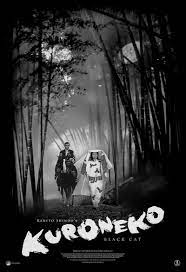
In feudal Japan during a period of civil unrest a group of marauding samurai come upon a small house in a bamboo grove. The men quench their thirst in a small stream. Upon entering the house they find Yone (Nobuko Otowa) and her daughter-in-law Shige (Kiwko Taichi). The men take turns raping the women while eating the house’s food stores. The samurai kill the women and set the house on fire before returning to the bamboo forest. In the ashes of the house a black cat appears. Through the cat the spirits of the murdered women become ghosts. As spirits, the women lure the samurai in, one by one, and viciously kill them, their throats torn out.
The Emperor (Hideo Kanze) is not happy that his samurai are being slaughtered and left all over the place. He berates the leader of the samurai, Raiko Minamoto (Kei Sato), for letting a ghost get the better of his men. Raiko is furious. He believes the killer is either an animal or a night prowler. He doesn’t believe that a ghost is responsible. Raiko, in turn, berates his men for not catching whatever it is that is killing his samurai.
Meanwhile Yone’s son Hachi (Kichiemon Nakamura) is in the north. Having been conscripted to fight the barbarians he doesn’t know that his mother and wife are dead. After a long battle he and the enemy general known as “Sunehiko the Bear” are the only ones left alive. When the barbarian gets stuck in the swamp Hachi takes advantage of the situation and kills him, cutting off his head. Hachi returns to present the head to Raiko. When talking of the battle he exaggerates and takes the battle name Gintoki. Raiko is impressed and promotes the now Gintoki to one of his samurai.
Gintoki returns home to find his home burned and his mother and wife missing. Gintoki returns to the capital. Raiko, now fully believing Gintoki is a great warrior, assigns him the task of finding and killing whatever or whoever is killing his samurai. When Gintoki finds the ghosts he believes they have taken the shape of his mother and wife. Slowly he comes to believe that they really are the ghosts of his loved ones. He learns that they have made a pact with the devil to return to human form and drink the blood of samurais. Shige gives up her vow so that she can spend seven nights with Gintoki. In return she is sent to hell. Yone is not so willing to give up her vengeance.
“Kuroneko” AKA “A Black Cat in a Bamboo Grove” AKA “The Black Cat” was released in 1968 and was directed by Kaneto Shindo. It is based on a supernatural folktale and takes place during a civil war during Japan’s Heian period. It is a Japanese, cat ghost, horror film and an excellent example of one.
The cinematography is wonderful. The lighting, with some excellent shadows and light, gives this Japanese film a feeling of noir. At times it is horrific and at times tender but always haunting.
An aspect of the film that I found interesting is the dynamic between Gintoki and the ghosts. The audience knows that the ghosts are Gintoki’s mother and wife but Gintoki can’t be sure. They look like his family and he knows that his house has been burnt down and his mother and wife are missing but ghosts can take on any form they want and they also lie. Gintoki makes love to the ghost of his wife actually believing that she is a ghost that looks like Shige. Creepy in itself but at different times his belief goes back and forth. Sometimes he believes they are his family and sometimes he believes they are just ghosts that look like his family.
The film is sometimes referred to as a companion piece to Shindo’s film “Onibaba”. It is similar in that it shows the plight of women in Japan during civil war is at the whim of men. In the two films how the women deal with the repression is slightly different for the women but the results end up the same for the men, deadly.

